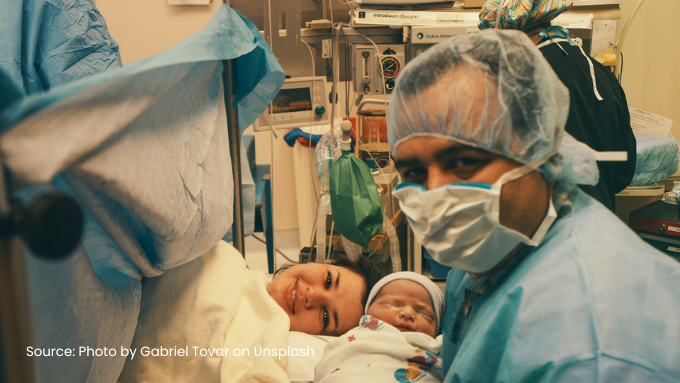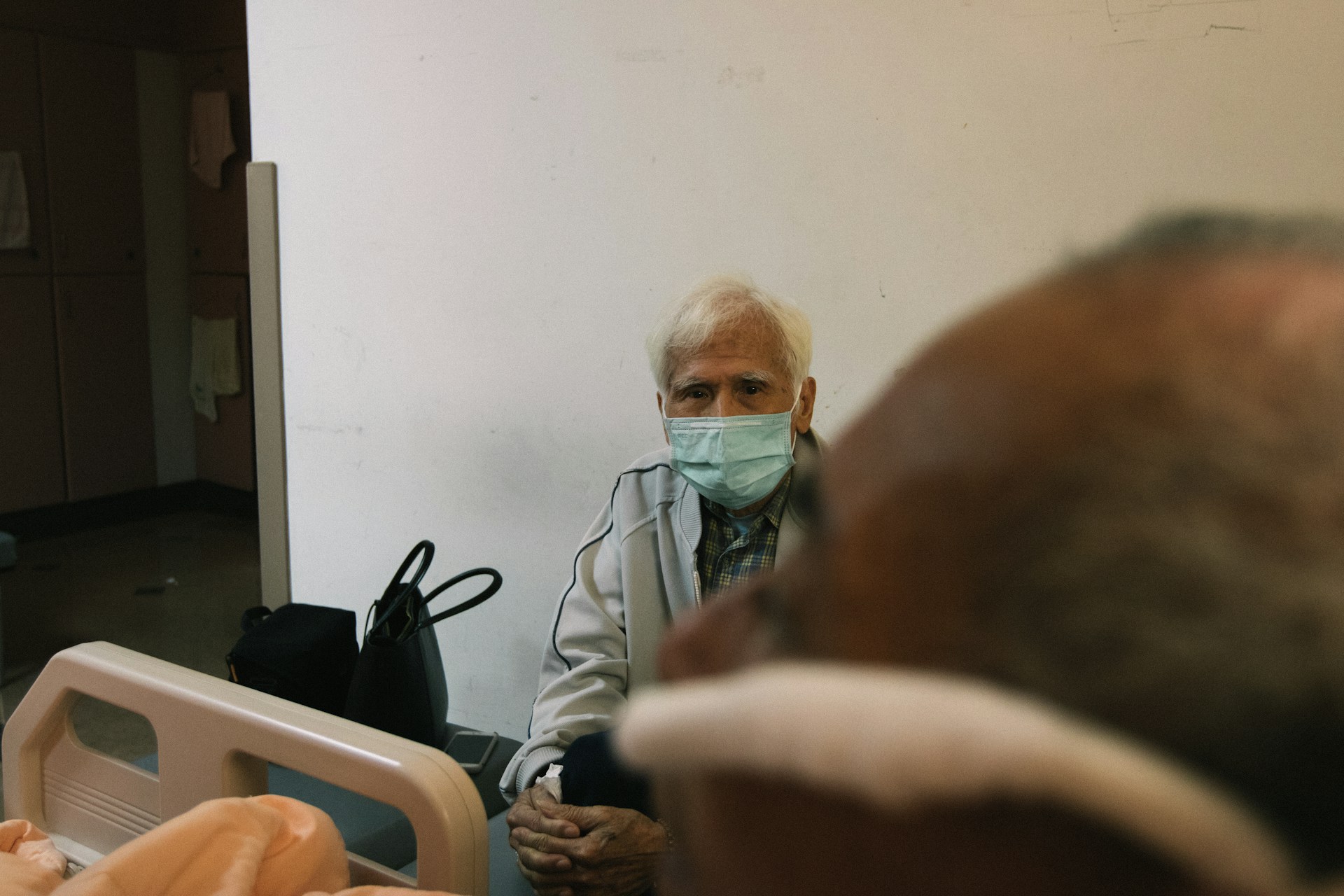Determinants for Low Birth Weight in Mothers Giving Birth during the Covid-19 Pandemic
Determinan Kejadian Berat Badan Lahir Rendah pada Ibu Melahirkan Selama Pandemi Covid-19

Downloads
Background: Low birth weight (LBW) remains a significant global health issue, leading to higher rates of infant and child morbidity and mortality. In 2022, Indonesia had a 12.58% rate, while in Kutai Kartanegara Regency, East Kalimantan, the rate was higher at 16.30%. The Covid-19 pandemic, which severely impacted East Kalimantan also influenced LBW rates.
Objectives: Analyzed the determinants of LBW incidence during the Covid-19 pandemic in Kutai Kartanegara.
Methods: This population of 1265 mothers delivered in four public health centers with the highest cases of BBLR. This study used a case control design for 240 mothers, including 120 mothers who gave birth to babies with low birth weight and 120 mothers who gave birth to babies with LBW. Data were obtained from e-cohort data according to specific inclusion and exclusion criteria. Data collection occurred from August until October 2022 through interviews with structured questionnaires and maternal child handbooks. Data analysis was performed with logistic regression.
Results: Determinant factors LBW were maternal nutritional risk (upper arm circumference <23.5 cm) (OR=2.800, 95% CI=1.237-6.340), history of anemia (OR=3.156, 95% CI=1.716-5.804), history of Covid-19 (OR=4.357, 95% CI=2.355-8.063), living with a smoker (OR=2.505, 95% CI=1.716-2.804), and not having health insurance (OR=2.744, 95% CI=1.435-5.247).
Conclusions: Internal factors such as age, under arm circumference, anemia, Covid-19, birth spacing, and parity and external factors (such as living with smokers, not having insurance) were interconnected in contributing to the risk of LBW, the pandemic further influenced these determinant factors.
UNICEF & WHO. Low Birth Weight Estimates. World Health Organization 4, 3–9 (2019).
Cutland, C. L. et al. Low birth weight: Case definition & guidelines for data collection, analysis, and presentation of maternal immunization safety data. Vaccine 35, 6492–6500 (2017).
Stevens, L. M., Lynm, C. & Glass, R. M. Low Birth Weight. Jama vol. 287 (2002).
Chmielewska, B. Effects of the COVID-19 pandemic on maternal and perinatal outcomes: a systematic review and meta-analysis. Lancet Glob Health 9, (2021).
Corbett, G. A., Milne, S. J., Hehir, M. P., Lindow, S. W. & O’connell, M. P. Health anxiety and behavioural changes of pregnant women during the COVID-19 pandemic. European Journal of Obstetrics and Gynecology and Reproductive Biology 249, 96–97 (2020).
Kemenkes RI. Buletin Stunting. Kementerian Kesehatan RI (2018).
Wen, J. Impact of COVID-19 pandemic on birth outcomes: A retrospective cohort study in Nanjing, China. Front Public Health 10, (2022).
Badran, E. F. et al. Adverse pregnancy outcomes during the COVID-19 lockdown. A descriptive study. BMC Pregnancy Childbirth 21, 761 (2021).
Lassi, Z. S. A systematic review and meta-analysis of data on pregnant women with confirmed COVID-19: Clinical presentation, and pregnancy and perinatal outcomes based on COVID-19 severity. J Glob Health 11, 1–13 (2021).
Harper, A., Rothberg, A., Chirwa, E., Sambu, W. & Mall, S. Household Food Insecurity and Demographic Factors, Low Birth Weight and Stunting in Early Childhood: Findings from a Longitudinal Study in South Africa. Maternal and Child Health Journal vol. 27 59–69 Preprint at https://doi.org/10.1007/s10995-022-03555-7 (2023).
Yang, L., He, J., Gallo, L. A. & Wen, J. Impact of COVID-19 Pandemic on Birth Outcomes: A Retrospective Cohort Study in Nanjing, China. (2019).
Liu, X. Prenatal anxiety and obstetric decisions among pregnant women in Wuhan and Chongqing during the COVID-19 outbreak: a cross-sectional study. BJOG 127, 1229–1240 (2020).
Selinger, C. P. et al. Impact of the coronavirus infectious disease (COVID-19) pandemic on the provision of inflammatory bowel disease (IBD) antenatal care and outcomes of pregnancies in women with IBD. BMJ Open Gastroenterol 8, e000603 (2021).
Du, M. Association between the COVID-19 pandemic and the risk for adverse pregnancy outcomes: A cohort study. BMJ Open 11, (2021).
Shahani, M. P. et al. Prevalence of Low-Birth-Weight Neonates during COVID-19 Pandemic in a Tertiary Care Hospital at Larkana, Sindh, Pakistan. J Pharm Res Int 91–96 (2021) doi:10.9734/jpri/2021/v33i43b32529.
Schiliro, M., Vogel, E. R., Paolini, L. & Pabelick, C. M. Cigarette Smoke Exposure, Pediatric Lung Disease, and COVID-19. Front Physiol 12, (2021).
Fajriana, A. & Buanasita, A. Faktor Risiko Yang Berhubungan Dengan Kejadian Bayi Berat Lahir Rendah Di Kecamatan Semampir Surabaya. Media Gizi Indonesia 13, 71 (2018).
Sindiani, A., Awadallah, E., Alshdaifat, E., Melhem, S. & Kheirallah, K. The relationship between maternal health and neonatal low birth weight in Amman, Jordan: a case-control study. J Med Life 16, 290–298 (2023).
Goisis, A., Remes, H., Barclay, K., Martikainen, P. & Myrskylä, M. Advanced Maternal Age and the Risk of Low Birth Weight and Preterm Delivery: a Within-Family Analysis Using Finnish Population Registers. Am J Epidemiol 186, 1219–1226 (2017).
Irwinda, R., Wibowo, N. & Prameswari, N. Cytokines storm in COVID-19 with dengue co-infection in pregnancy: Fatal maternal and fetal outcome. IDCases vol. 26 Preprint at https://doi.org/10.1016/j.idcr.2021.e01284 (2021).
Serce Pehlevan, O. et al. Cytokine responses to symbiotic and lactoferrin combination in very low birth weight neonates: a randomized control trial. Arch Argent Pediatr 118, e8–e15 (2020).
Figueiredo, C. P., Fontes-Dantas, F. L., da Poian, A. T. & Clarke, J. R. SARS-CoV-2-associated cytokine storm during pregnancy as a possible risk factor for neuropsychiatric disorder development in post-pandemic infants. Neuropharmacology 201, 108841 (2021).
Muthuka, J., Kiptoo, M., Oluoch, K., Nzioki, J. M. & Nyamai, E. M. Association of Pregnancy With Coronavirus Cytokine Storm: Systematic Review and Meta-analysis. JMIR Pediatr Parent 5, e31579 (2022).
Fall, C. H. D. et al. Association between maternal age at childbirth and child and adult outcomes in the offspring: a prospective study in five low-income and middle-income countries (COHORTS collaboration). Lancet Glob Health 3, e366–e377 (2015).
Mirzakhani, K., Shoorab, N. J., Akbari, A. & Khadivzadeh, T. High-risk pregnant women’s experiences of the receiving prenatal care in COVID-19 pandemic: a qualitative study. BMC Pregnancy Childbirth 22, (2022).
Ahmad, M., Sechi, C. & Vismara, L. Advanced Maternal Age: A Scoping Review about the Psychological Impact on Mothers, Infants, and Their Relationship. Behavioral Sciences 14, 147 (2024).
Erlingga Prihandani, Ahmad Syafiq & Roma Yuliana. Analisis Spasial Determinan Kejadian Berat Badan Lahir Rendah (BBLR) di Provinsi Kalimantan Timur. Media Publikasi Promosi Kesehatan Indonesia (MPPKI) 5, 1074–1080 (2022).
Mubasher, S. et al. Impact of short inter pregnancy interval on anemia, miscarriage and fetal low birth weight babies. Pakistan Journal of Medical and Health Sciences 13, 848–850 (2019).
Banerjee, M. Clinical Profile and Short-Term Outcome of SARS-CoV-2-Infected Neonates from a Government Medical College in West Bengal, India. J Trop Pediatr 68, (2022).
Figueiredo, A. et al. Maternal Anemia and Low Birth Weight: A Systematic Review and Meta-Analysis. Nutrients 10, 601 (2018).
Liu, D. et al. Maternal Hemoglobin Concentrations and Birth Weight, Low Birth Weight (LBW), and Small for Gestational Age (SGA): Findings from a Prospective Study in Northwest China. Nutrients 14, 858 (2022).
Kumari, S. et al. Maternal and severe anaemia in delivering women is associated with risk of preterm and low birth weight: A cross-sectional study from Jharkhand, India. One Health vol. 8 100098 Preprint at https://doi.org/10.1016/j.onehlt.2019.100098 (2019).
Figueiredo, A. C. M. G. et al. Maternal anemia and birth weight: A prospective cohort study. PLoS One 14, e0212817 (2019).
Hu, C. et al. Placentae for Low-Birth-Weight Piglets Are Vulnerable to Oxidative Stress, Mitochondrial Dysfunction, and Impaired Angiogenesis. Oxidative Medicine and Cellular Longevity vol. 2020 8715412 Preprint at https://doi.org/10.1155/2020/8715412 (2020).
Kebijakan, J., Indonesia, K., Simbolon, D., Kesehatan, P. & Bengkulu, K. Pengaruh Kepemilikan Jaminan Kesehatan Masyarakat Miskin Terhadap Status Kelahiran Dan Kejadian Stunting Pada Baduta Indonesia (Analisis Data Ifls 1993-2007). Jurnal Kebijakan Kesehatan Indonesia 03, 55 (2014).
Laksono, A. D., Wulandari, R. D. & Matahari, R. The determinant of health insurance ownership among pregnant women in Indonesia. BMC Public Health 21, 1538 (2021).
Wulandari, R. D., Laksono, A. D. & Matahari, R. Policy to Decrease Low Birth Weight in Indonesia: Who Should Be the Target? Nutrients 15, (2023).
Devaguru, A., Gada, S., Potpalle, D., Dinesh Eshwar, M. & Purwar, D. The Prevalence of Low Birth Weight Among Newborn Babies and Its Associated Maternal Risk Factors: A Hospital-Based Cross-Sectional Study. Cureus (2023) doi:10.7759/cureus.38587.
Anyanwu, O. A. et al. The Effects of the COVID-19 Pandemic on Nutrition, Health and Environment in Indonesia: A Qualitative Investigation of Perspectives from Multi-Disciplinary Experts. Int J Environ Res Public Health 19, 11575 (2022).
Cascella, M., Rajnik, M., Aleem, A., Dulebohn, S. C. & Di Napoli, R. Features, Evaluation, and Treatment of Coronavirus (COVID-19). (StatPearls Publishing LLC., 2024).
Copyright (c) 2024 Amerta Nutrition

This work is licensed under a Creative Commons Attribution-ShareAlike 4.0 International License.
AMERTA NUTR by Unair is licensed under a Creative Commons Attribution-ShareAlike 4.0 International License.
1. The journal allows the author to hold the copyright of the article without restrictions.
2. The journal allows the author(s) to retain publishing rights without restrictions
3. The legal formal aspect of journal publication accessibility refers to Creative Commons Attribution Share-Alike (CC BY-SA).
4. The Creative Commons Attribution Share-Alike (CC BY-SA) license allows re-distribution and re-use of a licensed work on the conditions that the creator is appropriately credited and that any derivative work is made available under "the same, similar or a compatible license”. Other than the conditions mentioned above, the editorial board is not responsible for copyright violation.












































